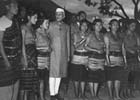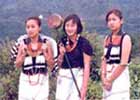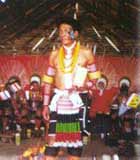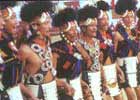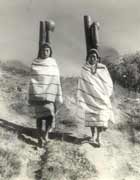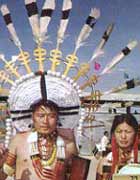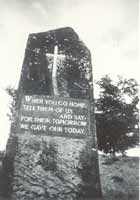The different tribes of Nagaland celebrate their distinct seasonal festivals
with a pageantry of colour and a feast of music. All the tribes have
their own festivals which they hold so dear. They regard their festivals
sacrosanct and participation in celebration is compulsory.
Most of these festivals revolve round agriculture, it being the
main-stay of Naga society. Over 85% population of Nagaland is directly
dependent on agriculture and lives in a thousand and odd villages
situated on high hill tops or slopes overlooking green valleys humming
with murmuring streams. In this blissful setting Nagas enjoy the
blessing of Nature with rare gusto. In most of the places agriculture
consists of mono crop.
Although some religious and spiritual sentiments are inter woven into
secular rites and rituals, the predominant theme of the festivals is
offering of prayers to a Supreme Being having different names in
different Naga dialects. At these festivals, the spirit of Gods are
propitiated with sacrifices by the Village Shaman for a bountiful
harvest either before the sowing or on the eve of harvest.
One of the well-known festival is the Sekrenyi Festival of the Angami
Naga tribe .
The Angamis celebrate Sekrenyi in the month of February. It normally
falls on the 25th day of the Angami month of "KEZEI" (in the
month of February). The ten-day festival is also called Phousanyi by the
Angamis.
The festival follows a circle of ritual and ceremony, the first being
Kizie. A few drops of rice water taken from the top of the jug, called
Zumho are put in to leaves and placed at the three main posts of the
house by the lady of the household. The first day begins with all young
and old going to the village well to bathe.
In the night, two young men will go to the well to clean it. Some of the
village youth guard the well in the night as no one is allowed to fetch
water after cleaning the well. The womenfolk, especially, are not
allowed to touch the well water. Hence they have to see that water is
fetched for the household before the well cleaning. Early the next
morning, all the young men of the village rise to wash themselves at the
well. The whole process is carried out in a ritualistic manner. The
young men will don two new shawls (the white Mhoushü and the black Lohe)
and sprinkle water on their breast, knees and on their right arm. This
ceremony is called Dzuseva (touching the sleeping water) and it assures
them that all their ills and misfortunes have been washed away by the
purified well-water.
On their return from the well, a cock is sacrificed by throttling it
with the bare hands. It is taken as a good omen when the right leg falls
over the left leg as the cock falls down. The innards of the fowl are
taken out hung outside the house for the Village elders to come and
inspect it. Beginning from the fourth day of the festival, a three-day
session of singing and feasting starts.
The Thekra Hie is the best part of the festival where the young people
of the village sit together and sing traditional songs throughout the
day. Jugs of rice-beer and plates of meat are placed before the
participants. On the seventh day the young men go for hunting. The most
important ceremony falls on the eighth day when the bridge-pulling or
gate-pulling is performed or inter-village visits are exchanged. Until
the close of the festival no one goes to the fields and all field work
ceases during this season of feasting and song.
The young unmarried girls with closely shaven heads sit down with the
bronzed youth sing tunes bygone ages, recreating a past where no care
touched the human soul.
Festivals and Fairs |
   |
